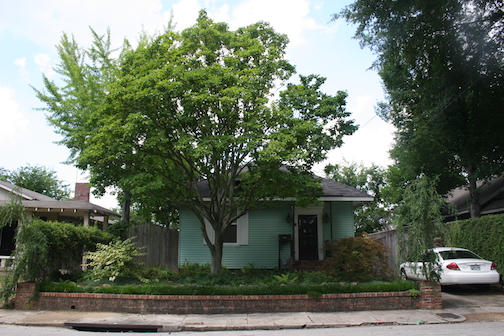New Orleans provides inspiration for Cooper-Young yard gem
By Sharron Johnson
In 1992 Robbie Dixon moved to Memphis from New Orleans looking for and needing a change of scenery after the passing of his partner. He first moved to Williford St. From there moved to Cox and Harbert and then set his sights on Cooper Young. He leaned toward the look and feel of his home in New Orleans — tall ceilings and space for a garden — which he found in his current home at 2160 Elzey. After a two-year lease he purchased the home and became a part of the Cooper-Young fabric.
The lovely Bungalow was built in 1923; it sits close to the street and has a small, quaint raised
front garden. As you approach you can’t help but notice a rather formal red brick retaining wall surrounding the front yard that is punctuated by square planters at each corner, standing like sentinels and planted with weeping yaupons. Mind you, the wall is knee high, but it adds a defining edge from the street. Atop the wall in the raised bed is a border of Arkansas field stone lined with monkey grass that gives a trimmed look to this mature cottage garden. The showpiece of the bed is a tulip magnolia tree that came with the house and a lovely lace leafed maple. Planted under the trees are hostas, ferns, ground sedums, and hellebores; a true dense shade delight. The property has a living chain link fence on either side, one covered with Carolina jessamine, the other with English ivy. Large wooden gates, framed with brick columns topped with round finials, separate the front yard from the back. You can’t help but notice the front porch decorated with wrought iron which is reflective of Dixon’s New Orleans connection.
Passing through the driveway gate toward the backyard, I noticed that every place that could be planted, was! This sunny location is perfect for growing veggies, herbs, and even bonsais that he manipulated and shaped from starter plants and saplings. Stunning!
As you continue, at the end of the driveway is a huge covered arbor Dixon built himself. He replaced an existing rotting arbor whose only means of support was two very mature wisteria vines. The 14’ x 20’ arbor is well thought out, equipped with two 54-inch ceiling fans that felt refreshing during an interview when it was 98 degrees in the shade. The arbor serves dual purposes, with a seven foot table for entertaining and a cover space for work. A faux finisher for the past 23 years, Dixon has a two-story studio directly adjacent to the arbor where he paints his magic.
Exiting from under the arbor through hanging white-tab topped curtains used for sun control, there is tucked away a formal, cottage-inspired garden you would never knew existed without seeing it. The center of the garden is surrounded by lush zoysia grass while all of the perimeter brick planter beds are brimming with irises, amaryllis, black-eyed susans, purple and white echinacea, solomon seal, ground ginger, various ferns, varieties of sedum, coral bells, columbine, hostas, fatsia, woodland poppies, ground orchid, ajuga, may apples, trillium, agapanthus, calla lily, eatable ginger, ground garden phlox, shamrock, acuba, dianthus, hardy begonias, pink and yellow buttercups, balloon flower, burgamansia and even a vining fern, with sun loving plants in the east bed, shade lovers in the west bed, and four mature crepe myrtles. Yard art is scattered throughout alongside figurines and small bronze statues atop preciously place stone from Christy Cut Stone.
Robbie’s most prized plant is a “Queen of the Night” night blooming cereus he affectingly calls “Big Mama.” A neighbor in New Orleans, whose blooms were truly something to behold, gave Dixon a cutting some 45 years ago. The pure white flowers begin to open around 10 p.m., close at first light, and the scent will lift you off of your feet. All definitely New Orleans Inspired!
The center of the garden is planted with veggies, lots of them. It is the most unique layout of space I’ve ever seen; 12” x 12” pavers create a checkerboard pattern on the ground creating the centerpiece of the garden. Every other paver has been removed, filled with soil, and planted with chest high okra, totaling 36 plants. Between the okra and the rear garden is a seating area. The rear garden is a traditional row and furrowed garden planting with three types of eggplant, cucumbers, six color bell pepper, and tomatoes.
According to Dixon, “this is a far cry from what it looked like when I moved in. A far cry indeed as the beds were planted with typical azaleas and forsythias lined up like toy soldiers.”

